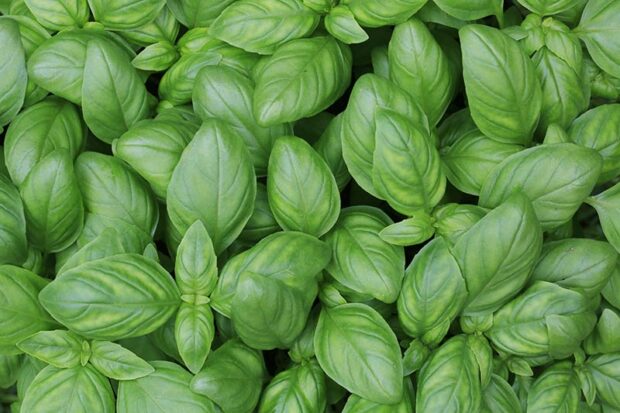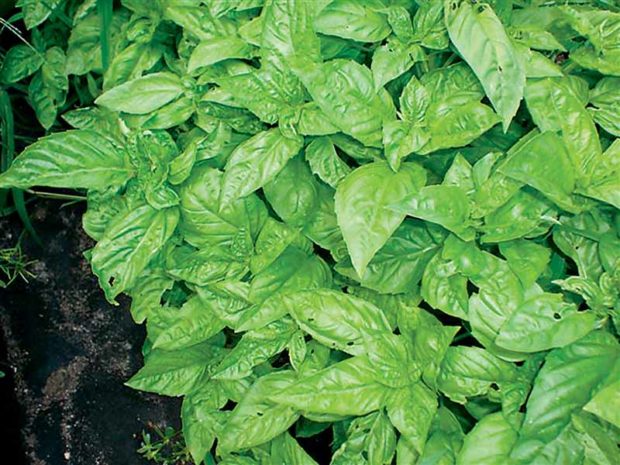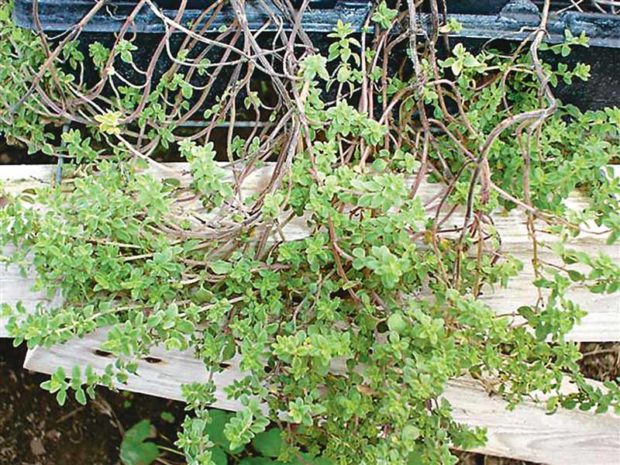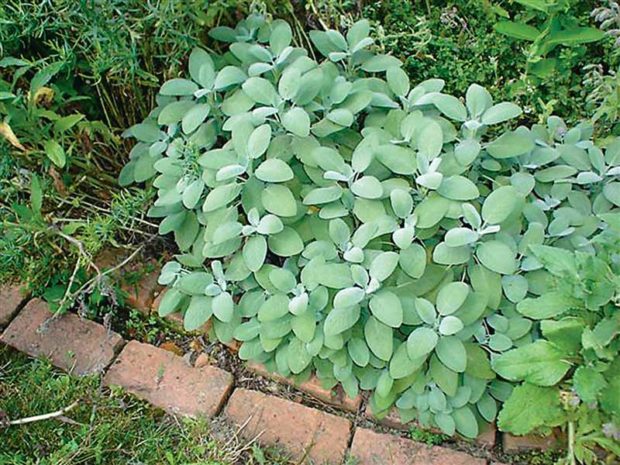Basil is the herb that has probably encouraged more people to become herb gardeners than any other. It is also likely that the most popular use for it is in Italian pesto sauce. But it is widely used in many other ways. For example, bunches of fresh basil can be used as fly repellents at entryways.
In folklore, bunches mixed with dill, artemisia, and rosemary were hung in the doorway nearest to the southwest corner of the house to repel evil spirits. If a young man wore a sprig of basil while courting, it meant that he was serious. Medicinally, it is used in teas, baths, and potions to mildly sedate, to aid poor digestion, to reduce fevers, to treat acne and insect stings, and to relax tired muscles. In the language of flowers, it can symbolize warfare and hatred, or love and best wishes depending on which reference you use (be sure the person to whom you are sending the symbolic bouquet is using the same flower dictionary that you are!). It is frequently planted among tomatoes with garlic and borage to repel the green hornworm.

Growing basil
Basil is an easy-to-grow annual needing sun, adequate water, reasonably rich well-drained soil, and warmth. It will show “frost” damage if the temperature falls below 40 degrees. Very cold water causes black spots to form on the leaves. It is commonly grown from seed, although seed-produced plants can contract a sudden wilt syndrome (fusarium) that turns the stems black and kills the plants in 1 or 2 days. Many seed companies offer improved varieties that do not have this problem.
Basil is easy to grow in pots, providing you take care of the basic necessities of sun, fertilizer and water. You can grow it on your windowsill if you have a sunny window. It is not a long-lived plant, so don’t bother to dig it up from the garden in the fall. Instead, start with new young plants to get you through most of the winter. The bugs that bother it include slugs, aphids and spider mites. If you get up one morning to find holes in the leaves, you most likely have a problem with slugs. Put sharp sand on the ground around the plants to discourage them. A strong stream of water usually washes the aphids and mites away.
Harvesting basil
When you are harvesting your basil to use fresh in the kitchen, cut the leaves and tender tips. Wash gently if necessary. When harvesting for drying, wait until the dew has dried from the plants and then cut only 1/2 to 2/3 of the plant at a time. Start harvesting in July when the plants are at least 12 inches tall. By harvesting early you avoid many of the insect problems, and the fresh leaves are still sweet and tender. Try to keep the plant from flowering, since once it flowers, the primary growth of the plant is done. However, the flowers are edible and make tasty additions to salads.
Basil turns black when it is frozen unless it is already processed. Make it into pesto and freeze it in an ice cube tray for easy wintertime use. To store the leaves dry, cut the whole plant before the first frost, rinse it if necessary, and pat it dry. Next, put a rubber band around the stems without making too large a bunch or it will turn moldy before it can dry, and hang the bunch in a dark and airy place until it is crispy dry. Store the dried basil in a bottle away from heat and light.
Basil varieties
There are about 35 varieties of basil in cultivation, and many more “named” varieties that are really duplicates of other ones. Herb nurseries carry a lot of them, and it is nice to be able to see and smell the plants before you buy them so there won’t be any surprises later on. Basil leaves have volatile oils that taste mainly of a mixture of anise, cinnamon, clove, lemon citrus, rose, thyme, and camphor. Plants and their oils can vary widely according to growing conditions. The varieties most commonly grown are categorized based on which oils are predominant, as in licorice basil, cinnamon basil, lemon basil, and holy basil (camphor and citrus). There are also basic basils, where the flavors and fragrances are quite evenly distributed including sweet, ‘Genovese,’ ‘Napolitano,’ ‘Nufar’ (probably the most resistant to fusarium wilt), Italian, pesto, spicy globe, and most of the purple-leaved varieties. Varieties can have large leaves, small leaves, purple or purple and green leaves, or ruffled leaves. There are small plants, tall plants, ball-shaped plants, and woody-stemmed shrubby plants, all of which are basils.
Basil recipes
There are many pesto recipes around—at least one or two in every cookbook or basil article. The basic recipe calls for 2 cups of fresh, chopped basil, 2 cloves of garlic, 3/4 cup of olive oil, 3/4 cup of grated Parmesan cheese, salt and pepper to taste, and pine nuts as a garnish. We mix these ingredients in the blender or food processor. Use pesto over pasta, added to soups and salad dressings, and mixed with bread crumbs to stuff mushroom caps. At the farm we add 1/3 cup of lemon juice and pour it over fresh tomatoes, pepper strips, zucchini strips, cucumbers, and cooked and chilled cheese ravioli for a wonderful summertime salad.
You can make basil vinegar by stuffing a pint canning jar 2/3 full of basil leaves, filling it with vinegar, and letting it steep for 2 or 3 weeks. This makes a great addition to salad dressings and barbeque sauces. Using the opal basil leaves will turn the vinegar a lovely pink color. Basil makes a nice addition to herbal tea mixes. The spicy basils add a lovely fragrance to potpourri blends.
Basil is a great addition to any garden and is readily available as baby plants during the growing season at your local garden center and farmers market. Buy a pot of basil and give it a try!
Jean and Roxanne Riggs operated Sunshine Farm and Garden in Oakland County, MI.



